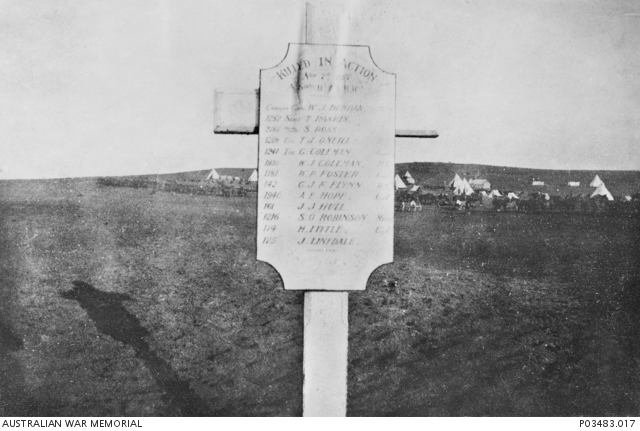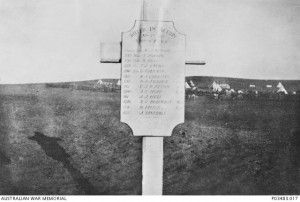Educated at Orange Public School and Newington College, William James Dunbar completed his theological training in 1910, and served in the Methodist ministry in Coonamble, Gilgandra, Kyogle and Tilba prior to his enlistment in August 1915. He had also spent six years as a part-time member of the 1st Regiment and 3rd Regiment.
William embarked for Egypt in September 1916 where he was assigned to the 12th Light Horse, but also spent some time with the 4th Light Horse. In May 1917 William was promoted to Chaplain Captain 4th Class. He took part in the Battle of Beersheba with the 11th Light Horse in October 1917.
A week later, fighting moved north to Tel-el-Sheria. Here the 11th and 12th Light Horse mounted a cavalry charge against Turkish positions. Two squadrons attacked on horse to be met by heavy gunfire. One squadron reached the Turkish trenches but in the ensuing battle every horse and 11 men were killed. The survivors were isolated in no man’s land. Volume 7 of The Official History of Australia in the war of 1914-1918 by HS Gullett describes what happened next:
During the afternoon a call was made for stretcher-bearers at the 11th Regiment’s headquarters just south of the wady. Chaplain W. J. Dunbar the regimental ” Padre,” an Australian Methodist clergyman who had joined the light horse as a trooper and had been promoted in the field, was among those who at once volunteered. Crossing the wady on his horse Dunbar rode forward under heavy fire, the one horseman on the landscape, to some little straw-stacks, where he engaged in dressing a number of wounded men. While he was there Trooper W. P. Forster,’ who had been with Brierty and had been only slightly wounded, rose from amidst the mass of dead horses, and, avoiding the Turks, ran towards the wady. Dunbar, despite the protests of a few men at the straw-stacks, at once dashed out to meet him. As Forster ran, the German machine-gunners opened fire. For some time the bullets cut up the dust close behind him; and, as he went on unhit, and the chaplain ran to join him, every Londoner and Australian lying on the exposed slope and breathlessly watching the two men, prayed for their escape. Forster was hit and fell. But he rose at once and, staggering on, met Dunbar; then both men, coming under a stream of bullets, were killed.
Orderly Room Sergeant of the 11th Regiment, HG Watkins of the Royal Air Force, later reported:
[Dunbar] was killed instantly while endeavouring to bring in a wounded man – all day he had been up in the firing line with our Squadron and evoked the admiration of all the men.
Captain Dunbar was buried the following morning alongside 12 others who were killed during the battle. The 11th Regiment later erected a cross on the gravesite bearing the names of the fallen.
In the 1918 pastoral address to the people of the Methodist Church of NSW the presiding minister stated:
William James Dunbar, unselfish, manly, devoted to duty, was killed in Palestine when bravely trying to rescue a wounded trooper. These brethren have, as the soldiers say, ‘gone west.’ They are beyond the rude ‘alarums of war. Their bodies lie in soldiers’ graves in far distant battlefields. But their ‘Last Post’ has been followed by the ‘Reveille’ of Heaven, calling them to the larger service of the King of kings.
William Dunbar is commemorated on the St John’s Presbyterian Church Orange Honour Roll and on the World War I Roll of Honour on the southern face of the Orange Cenotaph. There is also a commemorative plaque in Orange Cemetery, Presbyterian Block 2, Grave 88
In 1923 the Anzac Memorial Avenue of trees was planted along Bathurst Road to commemorate fallen WWI soldiers. A tree was planted in honour of “Rev WJ Dunbar”; it was donated by Tom Hawke. Very few of the trees are still standing today.


